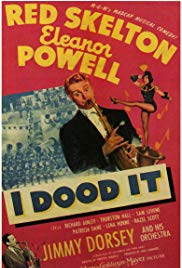
I DOOD IT
US, 1943, 103 minutes. Black and white.
Red Skelton, Eleanor Powell, Patricia Dane, John Hodiak.
Guests: Helen O’ Connell, Lena Horne, Bob Eberly, Jimmy Dorsey and His Orchestra.
Directed by Vincente Minnelli.
I Dood It is a standard Red Skelton comedy. He is teamed with Eleanor Powell. Which means that there is a lot of slapstick goofy humour in the Red Skelton style as well as some tap-dancing from Eleanor Powell – especially a lasso routine which rather boggles the imagination.
While there is the story of the show going on, there is also the comedy of the gold-digging dancer who senses that one of her suitors is an owner of a mine, only to discover after she marries him that he is a pants presser. There is a very humorous scene where she takes sleeping tablets and Red Skelton has to try to find a way of getting her onto the bed or onto the floor.
A lot of this material game from a Buster Keaton film, Spite Marriage. Keaton worked as a gag writer at MGM and worked with Red Skelton on A Southern Yankee. Skelton’s Watch the Birdie was a remake of Buster Keaton’s The Cameraman.
There is also a story, because this is World War Two, about Nazi saboteurs wanting to blow up some munitions in the basement of a building adjacent to the theatre. John Hodiak portrays a member of the cast who is really a Nazi spy.
There are guest sequences from Lena Horne and Helen O’ Connell, an emphasis on African Americans in MGM musicals at the time, though this was somewhat short-lived. Minnelli has directed Lena Horne the year before in Cabin in the Sky.
The next year Vincente Minnelli was to direct Meet Me in St Louis and move on to a very successful career directing musicals and melodramas, winning an Oscar in 1958 for Gigi.
1. The popularity of Red Skelton at the time? His comic style now? The goofiness? The mistaken identity? The slapstick?
2. The black and white photography, the restaurants and theatres? The saboteurs’ activity?
3. The musical score, the range of songs, the guest singers, Lena Horne and Jericho, Helen O’Connell? and the piano and audition, Bob Eberly, Jimmy Dorsey? Eleanor Powell’s dance numbers – and the techniques and style, for example the lasso?
4. The show business story, Connie as a dancer, her suitors, her impatience? Wanting to marry someone rich? The backers of the show? Joe and his constant attentions? Her not taking him seriously, thinking that he owned a goldmine, courting him? The dances together? The marriage? The sleeping pill sequence? Discovery of the truth, the separation? His becoming a hero because of the saboteurs? A happy ending?
5. The comedy? Joe as a pants presser, borrowing the clothes, getting them back on time, the exasperation of the employers? His attending the musicals? His devotion to Connie? Her ignoring him? Dancing, the decision to marry? His trying to manage her when she was drugged? The revelation of the truth? His involvement in the action? The happy ending?
6. The saboteurs’ story? Credible? The Nazis in America? Bob, his place in the show? His timing, the need for the digging? The munitions? The foiling of the plot by Joe?
7. How good a combination for the period, entertainment during the war? In Red Skelton’s career? In retrospect?